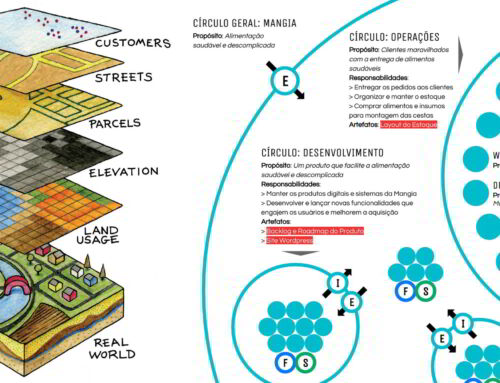Individuals are driven to behave according to the system in which they are inserted. People who work in a hierarchical environment won’t escape this effect. The chain of command, which is the authority system in place in most companies, generates some interesting behavior. Today we will explore these side effects to understand the importance of sync mode in the Organic Organization.
The chain of command determines that power resides in the top positions of a company. Owners and shareholders usually delegate some of their authority to directors, managers, superintendents, and so on. The basic premise is: you don’t have the authority to do something until someone else gives you permission. Power needs to be pushed from top to bottom.
That is why we see so many “empowerment” initiatives out there. Traditional organizations have realized that to be more responsive, power needs to be distributed. Otherwise the slowness takes over and nothing happens.
Obviously, individuals at the bottom of the pyramid already work with the paradigm of “powerlessness” in mind, usually waiting for action or command to come from above. A phenomenon of “outsourcing responsibility” is very common in this context. When something goes wrong, you blame the boss, the team, the company or another department. After all, you don’t have the authority change things. Note, however, that there is no victim here. Everyone believes in this system and thus contributes.
In order to foster self-organization, O2 seeks change this reactive context of victimization and outsourcing of responsibilities.
Causes of Organizational Reactivity
Many things contribute to people behaving in a certain way in the chain of command. Here are some reasons:
Poor organizational structure. If there are no clear, explicit, and described roles, it’s difficult to know who does what. Without clarity, every request seems a favor.
Marcos: John, can you analyze the access report for me?
John: I don’t think that’s my job.
Marcos: And who could help me with this?
John: I don’t know…
????
No clear channels to solve problems. If you have a problem that you asked for help, but didn’t got an answer, what do you do? In general, the only channel you can scale the problem is to your boss. But we all know that leadership positions are always bogged down and can’t handle everything. In this case, the lack of autonomy prevents you from taking the next step and you become stuck.
No effective ways to follow up resolutions. You make the request to John, but you don’t have transparency of the progress and you need to be asking him all the time what is happening. In addition, you don’t know what other projects John is taking on, nor the prioritization criteria he uses. Not easy…
Authority concentrated in a few people. Okay, you went through all this and decided to take action to change something. Maybe you will work on the project yourself, even though ou are not the most appropriate person. What happens? You take the initiative, but you are soon retaliated by someone else. Carlos says that you are out of your role and stepping on his.
Sync mode
In combination with a crystal clear organizational structure and a work review routine, the sync mode becomes especially powerful. As we wrote in the previous post, in the review mode participants feel “creative tensions” when they see what is happening in the circle. Whether they are opportunities for improvement or problems, these tensions make the circle move towards its purpose.
The first thing that happens in the sync mode is the creation of a tension list. The facilitator asks the participants: Do you have any tensions to add to the list? If so, say two words to name it. The participants then say their tensions and the secretary records a list like this:
- Carlos: CRM Problem
- Diego: Notification
- Jane: Holidays
- Carlos: Migration data
After the list is built, the facilitator goes through each tension, asking the participant: What do you need? The participant then engages other people as needed, in the roles they represent in the circle. Then the secretary records any actions or projects that people have accepted to solve the tension.
The purpose of the sync mode is to process tensions quickly, often into new projects, actions, requests, and information sharing. This can be done any time, including outside circle meetings. The sync mode is only a convenient time to handle many tensions, since everyone is gathered.
How Sync Reduces Organizational Reactivity
Some features of this mode are very effective at counteracting organizational reactivity. They are:
Pragmatism. The mode is extremely objective. The facilitator promptly starts by asking what the person who is feeling the tension needs. Responsibility is placed on the individual who brings the problem and not on third parties. Obviously the other participants can help. But the center is always the person who felt the tension.
Goodbye outsourcing. Because the focus is on the participant who feels the problem, it’s difficult to outsource responsibility to the group. For example, if the person says: “What are we going to do about it?“, the facilitator would probably quickly interrupt and ask “Who has the authority to decide that?“. The secretary then would check the circle structure and could reach the conclusion that there is no one accountable or no restriction regarding the decision. Then the facilitator would go back to the participant and say, “There is no one accountable for this and no limitation of authority in place, so you can make the decision yourself or propose a new role for it. What do you need?”
This process is extremely uncomfortable at first. Even the most proactive people realize that at times they outsource or exempt themselves from responsibility. But as we exercise this muscle, the organization increases its agility.
Recording the outputs. The division between facilitator and secretary allows the first to concentrate on the dynamics of the meeting, while the second records outputs. Any accepted action or project will be logged as an “output” or “result” of the meeting. The progress of those accepted outcomes can be followed up in the review mode of the next circle meeting.
Clear language for possible outputs. O2 has a specific vocabulary for any decision made at meetings. For example, sync mode outputs are usually projects or actions. These terms have clear and practical definitions, which makes the process much more structured.
Things the sync mode can’t help
The sync mode is incredible, but there are some things that are out of its purpose.
All requests, be them actions or projects, are made using the current circle structure. However, in some cases it’s necessary to change the underlying structure. For example, like creating a new role. This won’t be accomplished in sync, but rather in the adapt mode.
Things related to tribal space also don’t have much space here. For example, if a participant brings discomfort, stating that he would like to be more respected, this wouldn’t be handled in the sync mode. Such a tension is valid and awesome, but it doesn’t belongs to roles (organizational space), but rather to people (tribal space). O2 seeks to separate these two spaces, so that one doesn’t pollute the other. Still, there is a specific way to deal with tribal issues, called care mode. We’ll talk about it soon!
Did you enjoy the post? Leave a comment or question below. In the next post we will talk about the adapt mode.





Leave A Comment